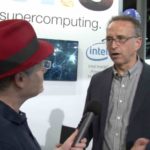In this video from ISC 2016, Bob Wisniewski from Intel provides an update on OpenHPC community activities. “OpenHPC is a collaborative, community effort that initiated from a desire to aggregate a number of common ingredients required to deploy and manage High Performance Computing (HPC) Linux clusters including provisioning tools, resource management, I/O clients, development tools, and a variety of scientific libraries. Packages provided by OpenHPC have been pre-built with HPC integration in mind with a goal to provide re-usable building blocks for the HPC community. Over time, the community also plans to identify and develop abstraction interfaces between key components to further enhance modularity and interchangeability.”
Thomas Sterling presents: HPC Achievement and Impact 2016
Thomas Sterling presented this keynote at ISC 2016 in Frankfurt. “Even as the hundred petaflops era is coming within sight, more dramatic programs to achieve exaflops capacity are now emerging with the expectation of this two orders of magnitude advance in the early part of the next decade. Yet the challenges of the end of Moore’s Law loom ever greater, threatening to impede further progress. Innovations in semiconductor technologies and processor socket architecture matched with application development environments improvements promise to overcome such barriers. This keynote presentation will deliver a rapid-fire summary of the major accomplishments of the last year that promises a renaissance in supercomputing in the immediate future.”
For SGI, This is Supercomputing at ISC 2016
In this video from ISC 2016, Gabriel Broner from SGI describes the company’s innovative solutions for high performance computing. “As the trusted leader in high performance computing, SGI helps companies find answers to the world’s biggest challenges. Our commitment to innovation is unwavering and focused on delivering market leading solutions in Technical Computing, Big Data Analytics, and Petascale Storage. Our solutions provide unmatched performance, scalability and efficiency for a broad range of customers.”
Intel Xeon Phi Developer Access Platform at ISC 2016
In this video from ISC 2016, Kirti Devi from Intel describes the new Intel Developer Platform for the Intel Xeon Phi processor. “With this program, Intel and its partner Colfax are widening early levels of access, support and training for the widely anticipated next-generation Intel Xeon Phi processor release. The Developer Access Program gives developers the opportunity to begin leveraging key new capabilities in the processor before they are generally available. That means developers will have time to work to parallelize and vectorize their code and look for opportunities to exploit the massive performance capabilities that KNL offers so workloads are ready for prime time when customers deploy their next-generation systems.”
Video: Analyst Crossfire from ISC 2016
In this this lively panel discussion from ISC 2016, moderator Addison Snell asks visionary leaders from the supercomputing community to comment on forward-looking trends that will shape the industry this year and beyond.
Calyos Demonstrates Water Free Cooling at ISC 2016
In this video from ISC 2016, Olivier de Laet from Calyos describes the company’s innovative cooling technology for high performance computing. “The HPC industry is ever facing is facing the challenge of ever-increasing cooling requirements. While liquid cooling cooling looks to be the best solution, what if you could achieve the same efficiencies without out using water and pumps? Enter Calytronics, cooling technology that is as simple as a heat pipe and as performant as liquid cooling.”
Intel to Distribute SUSE High Performance Computing Stack
“The SUSE and Intel collaboration on Intel HPC Orchestrator and OpenHPC puts this power within reach of a whole new range of industries and enterprises that need data-driven insights to compete and advance. This is an industry-changing approach that will rapidly accelerate HPC innovation and advance the state of the art in a way that creates real-world benefits for our customers and partners.”
SGI Pangea is Industry’s Top Commercial Supercomputer on TOP500 List
At ISC 2016 this week, SGI announced that Total’s SGI ICE X supercomputer, Pangea, was recognized as the industry’s top commercial supercomputer in the prestigious TOP500 list. “Our SGI ICE XA systems lead in delivering application performance in both homogeneous systems and hybrid systems with CPUs and accelerators,” said Gabriel Broner, vice president and general manager, high-performance computing at SGI. “Our production supercomputers continue to enable our customers to innovate and lead in their field, and occupy prominent positions in the prestigious TOP500 list.”
Video: Rolling Out the New Intel Xeon Phi Processor at ISC 2016
In this video from ISC 2016, Barry Davis from Intel describes the company’s brand new Intel Xeon Phi Processor and how it fits into the Intel Scalable System Framework. “Eliminate node bottlenecks, simplify your code modernization and build on a power-efficient architecture with the Intel Xeon Phi™ processor, a foundational element of Intel Scalable System Framework. The bootable host processor offers an integrated architecture for powerful, highly parallel performance that will pave your path to deeper insight, innovation and impact for today’s most-demanding High Performance Computing applications, including Machine Learning. Supported by a comprehensive technology roadmap and robust ecosystem, the Intel Xeon Phi processor is a future-ready solution that maximizes your return on investment by using open standards code that are flexible, portable and reusable.”
Interview: Dr. Eng Lim Goh on the Latest Trends in High Performance Data Analytics
In this video from ISC 2016, Dr. Eng Lim Goh from SGI discusses the latest trends in high performance data analytics and machine learning. “Dr. Eng Lim Goh joined SGI in 1989, becoming a chief engineer in 1998 and then chief technology officer in 2000. He oversees technical computing programs with the goal to develop the next generation computer architecture for the new many-core era. His current research interest is in the progression from data intensive computing to analytics, machine learning, artificial specific to general intelligence and autonomous systems. Since joining SGI, he has continued his studies in human perception for user interfaces and virtual and augmented reality.”












